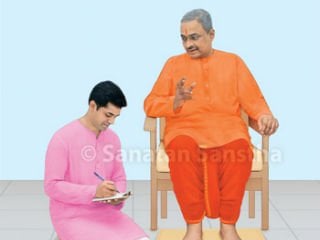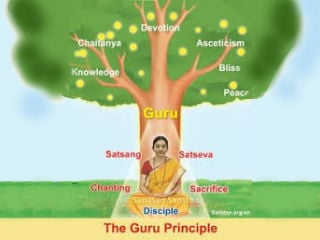1. What is True nature of the Guru?
A. A disciple’s faith
‘The Guru depends on faith. In one’s faith itself lies the greatness of the Guru. The Guru too depends on your faith. He lies in your faith.’ – Saint Bhaktaraj
Implied meaning : In “The Guru depends on faith. In one’s faith itself lies the greatness of the Guru” the Guru refers to the Guru’s external form. Only if one has faith in a Guru can He function as a Guru. “The Guru too depends on your faith. He lies in your faith” refers to the Omniscient Guru within oneself.’
B. The clarifying reply
‘According to me the question expressing doubt is in itself the disciple and the answer giving the clarification is the Guru. As long as the darkness of ignorance in the form of questions is not eliminated and the genesis of wisdom in the form of answers giving clarification does not occur, the debate shall continue. In reality the Guru and the disciple are one and the same.’
C. The Guru principle is one
All Gurus are the same internally though externally Their physical appearances may differ. Just as the milk oozing from any udder of a cow is equally pure and clean, so also there is only one Guru principle in all Gurus and the frequencies of Bliss (Anand) emanating from all of Them are the same. Just as sea waves advance towards the shore the waves of Brahman / God, that is the Guru come towards the society. The taste of water in all the sea waves is the same. Similarly the principle in all the Gurus is one and the same, that is Brahman. If a water tank has many outlets whether small or large, the same water from the tank flows out from all of them. However varied the shapes of bulbs maybe, when electricity flows through them only light is emitted from all of them. In the same way, though Gurus differ in physical appearance, yet the Guru principle that is the God principle in Them is the same.
The Guru does not mean a physical body. Since Gurus are devoid of a subtle body [sukshma deha] (mind) and a causal body [karan deha] (intellect) They can communicate with the universal mind and universal intellect. Thus since the mind and intellect of all Gurus is the universal mind and universal intellect, They are one.
2. How should one receive the Guru at one’s home?
A. When the Guru comes home one should decorate the house with flowers, lit lamps and by elegantly drawing designs on the floor with special white powder and colours (rangoli). One should remember Saint Tukaram Maharaj’s quote, “The day saints come home is in itself the day of Divali or Dasara”. This also facilitates the development of spiritual emotion towards the Guru. Just before His expected arrival one should keep half a cup (vati) of milk, a tumbler of lukewarm water to wash His feet and a towel to wipe them, at the entrance. Similarly, a platter containing sandalwood paste (gandha), turmeric (haldi), vermilion (kumkum), consecrated rice (akshata), flowers, a lamp (niranjan) with clarified butter and an offering of some sweetmeat or sugar should be kept ready for performing His arti (the ritual of waving lit lamps).
One should wait on the road to receive the Guru at the scheduled time of His arrival. When He arrives one should escort Him to one’s home with honour. One should enter the house before Him and request Him to step onto a wooden platform (pat) placed outside the threshold of the door. Then one should pour milk from the cup (vati), on His feet with the left hand and with the right hand rub the milk onto them. Keeping the cup of milk aside one should pour lukewarm water from the tumbler over His feet with the left hand and they should be washed with the right hand. In cities, due to tiled flooring there is a likelihood of collection of water. So instead of a wooden platform the Guru should be requested to stand on a big plate (parat). At such times His feet should be washed only with a spoonful of milk and then with water. Since there is a likelihood of the milk and water accumulating in the plate and of making the Guru’s feet greasy, less milk should be used. The Guru should then be requested to take one or two steps with wet feet and then they should be wiped with a towel. The big toes of both the feet should then be ritualistically worshipped in the usual way, with sandalwood paste, consecrated rice, flowers, turmeric powder and vermilion. This worship should be repeated on the forehead of the Guru, midway between the eyebrows and He should either be offered a flower or should be garlanded. Then He should be offered arti with a lit lamp (niranjan) waved around His head thrice. Finally a pedha or any other sweetmeat should be offered or fed to Him. Lastly, offering obeisance (namaskar) He should be escorted to His seat or room in the house.
If the Guru looks tired after a long journey then instead of making Him stand at the doorstep He should be offered a seat in the house and then worshipped ritualistically. If He is very tired then instead of worshipping Him immediately one should allow Him to rest. Ritualistic worship can be performed after sometime.
However, when doing all this one should remember the basic point that rather than external decoration, doing spiritual practice as advised by the Guru is more important. The Guru is appeased faster with internal decoration, that is with one’s spiritual practice rather than with external decoration. The importance of decorating the house when the Guru comes, preparing His favourite dishes, etc. is not even 1% in contrast to doing the spiritual practice advised by Him, which is of 100% importance.
B. Throughout the duration of His stay at one’s place the Guru should be worshipped every morning just like other deities. If not the entire ritual atleast sandalwood paste (gandha) and vermilion (kumkum) should be applied to the Guru’s forehead. Since it is important to serve the Guru when He is staying at one’s place one often does not find time to ritualistically worship the Guru’s photographs and deities as usual. Then it does not matter if one does not perform that worship. If possible one may also ask someone else to do so. When the Guru is departing from one’s home vermilion should be applied on His forehead and He should be offered arti with a lit lamp (niranjan). Whatever offering one makes to the Guru should be preferably done when He is worshipped either on arrival or before departure. If that is not possible then it may be done during worship on any other day during His stay.
C. One should take leave from the workplace and remain with Him constantly.
D. Water for His bath and His clothes should be kept ready. After His bath He should be ritualistically worshipped as described above by applying sandalwood paste (gandha) to His forehead and offering flowers and consecrated rice (akshata) at His feet.
E. Separate towels for wiping His face and hands and feet should be kept. After He washes His face and hands, He should be offered the towel meant for wiping His face and hands. His feet should be wiped outside the bathroom if He happens to stand there or otherwise after He sits down.
F. The meals prepared for Him should include His favourite dishes and should be in accordance with the dietary restrictions that He follows. If one is unaware of what they are then one should ask one of His close disciples. After the meal He should be offered water to wash His hands and a towel to wipe them.
G. One should wash the Guru’s clothes oneself and iron them as well. One should not get them washed from a servant or ironed in a laundry.
H. When fanning the Guru it should coincide with His or one’s own breath and should not be mechanical like the electric fan which operates without any spiritual emotion.
I. One should welcome everyone accompanying the Guru cordially.
J. When the Guru comes home, with His permission one should invite the other disciples of the Guru and also those who like to pay their respects (darshan) to saints. All those coming for the Guru’s darshan should be offered tea, snacks and meals courteously. Their accomodation, etc. too should be looked after. This is because they have come to visit the Guru and are not one’s unwanted guests! [Refer to the point ‘Visiting a disciple’ in ‘Science of Spirituality : Chapter 6 – Path of Guru’s Grace (Gurukrupayoga)’.]
3. What should one ask the Guru for ?
A. Do not take undue advantage of the Guru ! : An individual once prayed to the Guru for cinema tickets! The real disciple of course, never asks the Guru for such materialistic things. The disciple, who is a newcomer however, should not entertain such thoughts even in jest.
B. ‘Do not ask me for happiness, ask for the strength to endure unhappiness.
The implied meaning: Since happiness is from the Great Illusion, it is temporary. Hence, one should not ask the Guru for it. Simultaneously one should bear in mind that granting everlasting Bliss is the real mission of the Guru. However, if one has to experience unhappiness according to one’s destiny, then the Guru definitely gives one the strength to endure the unhappiness arising from those traumatic events. So, it does not matter, if one asks the Guru for inner strength to face them.’
C.
| The Guru : | What do you want? |
| The disciple : | I wish that You cherish my memory in Your heart (I cherish Yours in mine) constantly. |
D. ‘Shri Shankaracharya said, “If you have anything to ask, then do so.” Tears welled in Padmapad’s eyes. Folding his hands in obeisance he said, “Guru, my Lord (Acharyadev) now we have nothing left to ask. By Your grace may we follow the path that You have chalked out by Your lifelong efforts. You alone are the guiding light of our lives. Bless us so as to develop the potential to follow in Your footsteps”.’
E. Never ask the Guru for anything: Harbouring the faith that ‘one’s Guru is Omniscient and that He knows what is useful or necessary for one, more than oneself ’ one must continue to carry on spiritual practice. If one asks for something without deserving it, He will not grant it. But if one deserves it, then He grants it without one’s asking for it. Then why should one ask for anything at all?
F. After offering one’s body, mind, wealth and life to the Guru need one ask the Guru for anything else?
G. No matter how great the obstacles are,
Instead of seeking help from others,
He knows that obstacles can do nothing before
Lord Rama’s Name. – Shri Eknathi Bhagvat 24:341
Meaning: A real seeker does not pray even to the Sadguru, if faced with severe obstacles; as he has such intense faith that no obstacle can survive the chanting of The Deity’s Name. Here, Deity Rama’s Name refers to The Deity’s Name.
4. What is the importance of
serving sagun form of the Guru?
Since the Guru is an unmanifest (nirgun) principle one tends to neglect His physical form. In reality too service of the unmanifest principle is 70% important while that of the manifest (sagun) form is only 30% important. Most disciples start with the manifest and then go to the unmanifest. Dr. Jayant Athavale however had gone in the reverse direction. He had yet to do service of the manifest. Although it is just 30% important yet to make progress and attain Absoluteness (Purnatva) service of the physical form is also necessary. He realised the importance of serving a Guru in the physical form when in 1995 during Baba’s illness He stayed with Baba for eight months. If one is unable to serve the Guru’s physical form then one may serve one’s grandparents, parents, etc. considering them to be the Guru’s form. This too becomes service of the Guru’s manifest form. Pundalik too realised God by serving His parents alone.
5. What is the correct way of
offering obeisance to the Guru ?
Placing one’s head on the Guru’s feet: If one meets an acquaintance, one always smiles, shakes hands with, greets him with obeisance (namaskar) or if he is elderly then offers obeisance by touching his feet. Whether one meets the Guru at one’s home, in His ashram, on the road or elsewhere one should place one’s head on His feet. Placing the head on someone’s feet denotes the surrender of the intellect.
The amount of frequencies of Energy (Shakti) or Bliss (Anand) emanating from a Guru and a saint
- The amount of frequencies of Energy (Shakti), Bliss (Anand) or Serenity (Shanti) present depending on the spiritual level
| The spiritual level | The amount of frequencies of Energy, Bliss or Serenity % |
|
|---|---|---|
| 1. An average person (20% level) |
Energy | 10 |
| 2. A saint of 70% level | Predominantly Energy | 30 |
| 3. A saint of 80% level | Predominantly Bliss | 60 |
| 4. A saint of 90% level | Serenity | 90 |
-
The amount of frequencies of Energy or Bliss emitted through various organs: First carefully observe the eyes, palms, feet and other parts of the body in the Guru’s sketch given below and note which part emits more Energy or Bliss. Only then read further.
Every individual may not get spiritual experiences from such experiments. The table below gives information regarding the spiritual experiences of only those who are able to perceive a little in the subtle dimension after having done some spiritual practice.
| The organ | The amount of frequencies of Energy or Bliss emitted % |
|---|---|
| 1. The eyes | 20 |
| 2. The hands | 20 |
| 3. The feet | 40 |
| 4. Other organs | 20 |
| Total | 100 |
From the above table one will realise why one offers obeisance to saints by placing one’s head on Their feet instead of merely folding one’s hands in the obeisance (namaskar) posture. At that time, a saint often touches one’s back or head. This bestows an even greater benefit. When one places one’s head on the feet of a saint, Energy or Bliss frequencies enter one’s body through the Brahmarandhra in greater quantities.
6. Why should one not go in search of a Guru ?
The Guru principle being very subtle and a seeker’s power of perception being more of the gross and very little of the subtle dimension, in Spirituality, one cannot find a Guru (Spiritual guide) despite a search. It is the Guru who chooses and spiritually uplifts His disciples. Once a seeker attains a spiritual level of more than 50%, the Guru Himself accepts him as His disciple. However, despite the spiritual level being just 40%, if a seeker has intense motivation to make spiritual progress, then he is blessed with a Guru.
7. Why should one not test the Guru ?
If one is able to develop faith only after testing, then one will have to test the Guru. The examiner however is superior to the pupil. If one feels one is superior, then how can one accept Him as one’s Guru ?
Reference : Sanatan Sanstha’s Holy text, ‘Gurukrupayoga’ and ‘The Disciple’

 The one and only Guru-disciple tradition of the Sanatan Sanstha which has proven special in...
The one and only Guru-disciple tradition of the Sanatan Sanstha which has proven special in... Who is proclaimed a Saint as per Science of Spirituality ?
Who is proclaimed a Saint as per Science of Spirituality ? Faith & Guru
Faith & Guru Who is a real Guru ?
Who is a real Guru ? The Guru Principle
The Guru Principle Offering gratitude unto the Holy feet of the Guru is true Gurudakshina !
Offering gratitude unto the Holy feet of the Guru is true Gurudakshina !